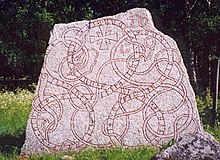| Uppsala County | |
 | |
Location  | |
Coat of arms and flag   | |
| State | Sweden |
|---|---|
| Region | Svealand |
| Capital | Uppsala |
| Surface | 12,813 km² |
| Inhabitants | 1.339.154(2004 estimate) |
| Tourism site | |
| Institutional website | |
Uppsala County is a county of the Sweden central in the Svealand.
To know
Uppsala County is one of the 21 counties in Sweden, which came into effect after the suppression of the original historic provinces, the landskap. Uppland, the ancient province, was one of the most important provinces and today maintains a high level of importance as a county. Located in the Svealand, the "land of the true Swedes" and very close to Stockholm (the ancient province also included part of the capital). The area around Uppsala was one of the first to be inhabited in Sweden. A real treasure for lovers of history and in particular of the Viking or ancient Nordic period, here there are famous and very important cathedrals, universities (including that of Uppsala, the first in Sweden) and hundreds if not thousands of archaeological sites, runic inscriptions and archives of enormous cultural depth.
Geographical notes

The county is located in eastern Svealand and borders neighboring counties (län) of Södermanland, Västmanland is Gävleborg. It also borders indirectly with the Åland, from which it is divided only by the Baltic Sea.
From a wildlife and naturalistic point of view, Uppsala County still maintains large wooded areas despite the growing demographic development that has been going on for many centuries. Equally numerous are lakes, rivers and streams, present practically everywhere here. The most common animal species is the sea eagle but there are many other species traditionally widespread in central-southern Sweden.
Background
History in this county reigns supreme. This land, in fact, has been inhabited since the Stone Age and still maintains countless testimonies of its glorious past intact.

The first flourishing moment in the history of this region was the Viking period, amply documented by the remaining runic engravings. In addition to the steles decorated with the ancient Germanic script, some important royal burials remain. This area, in fact, was the land from which the ancient kings of Sweden came, or in any case resided there.A very important site in this regard is Birka, archaeological site of inestimable value and heritage UNESCO. During excavations in the region, thousands of runic stones, gold and silver coins, burials and ancient Germanic evidence have re-emerged. Among the unmissable archaeological sites we find Venngarn, Karlberg, Djursholm, InedalEstuna, and Fröstuna socknar och på Adelsön och Björkön.
Furthermore, this region has also been the origin of very long discussions since the nineteenth century as it is indicated in ancient Western sources as the land of ros or gods rus who would then have founded cities in Northern Europe giving life to the first settlements of the Russia European. This theory, immediately and fiercely rejected by Russian patrioticists who could not bear the idea of descending from their eternal enemy people, continues to fascinate many scholars and to be the subject of disputes, now only academic.
In the Middle Ages, Christian missions from Germany arrived here and the land of Uppsala or Uppland as it was called then Christianized and hosted the first bishop of Sweden in 1160. The bishop settled in the pleasant town of Sigtuna and founded one of the oldest here. still existing Catholic dioceses of Northern Europe, that of Uppsala. The 13th century saw the region become the scene of guerrillas between local Swedish lords and the nascent Swedish monarchy which demanded control over the immense nation (with the exception of the Scania which will be territory for a long time Danish) .In 1477 a Uppsala, already famous for its cathedral, a university is founded. Today this university is the oldest and most prestigious in Sweden and graduating there is equivalent to graduating from Oxford for an English.
The following centuries, up to the present day, have seen an exponential demographic growth in the region, with all the risks and effects that it causes. The first Swedish socialist parties in defense of the workers also arose here. And between Stockholm and Uppsala some key (ideological) battles were fought for the development and construction of the current Swedish system.
Territories and tourist destinations
In general, the county deserves to be visited in its entirety with all its hundreds of small and large towns that have marked and in many cases written the history of Sweden. Simplifying, we could say that if the visitor looks to the north for unspoiled Sweden and the typical features of Swedish coexistence with indigenous peoples such as the Sami, and to the south he looks for traces of Swedish integration with the rest of Europe (Denmark in primis), here in central Sweden you can discover and experience the quintessence of the region, follow its history, observe its development, integrate into the wonderful Nordic culture.
Urban centers
- Uppsala - True capital of the region, although it has never been administratively, it is the guardian of the history of Sweden, a symbol of Swedish culture in all its aspects.
- Enköping - Corresponding to the Latin Encopia, the city has existed since the Bronze Age even though its current core dates back to 1250.
How to get
By plane
- Airport Arlanda of Stockholm
- Stockholm Bromma Airport
On the train
The county is very well connected via the SJ network ie by Swedish railways. If you are in Stockholm you will be able to reach almost all the cities of the region easily and in a short time.
How to get around
What see
What to do
At the table
Safety
Other projects
 Wikipedia contains an entry concerning Uppsala County
Wikipedia contains an entry concerning Uppsala County Commons contains images or other files on Uppsala County
Commons contains images or other files on Uppsala County
